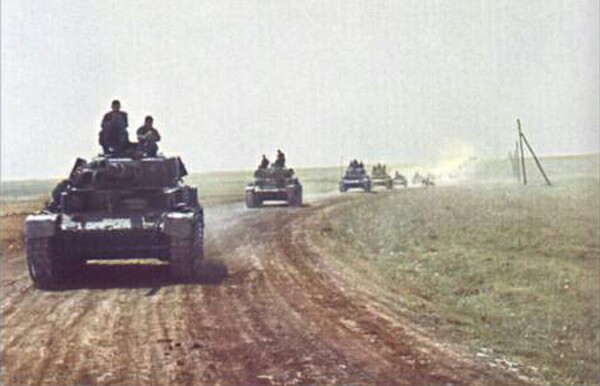
By now we’re at the fourth installment in this new War in the East series, and you’re probably wondering if I’m ever going to attack another hex, or if I’m going to just keep going to my closet and pulling out different games about Stalingrad. I assure you that both of those things are definitely going to happen. But I also promise that before this post is done, I will have attacked many hexes and shown you several actual in-game screenshots. But before that happens, I have to tell you a story. It’s kind of long, but at the end you’ll know a little more about what I’m trying to tell you. If you don’t like it, I promise to give you your money back.
Full disclosure: I’m not a board wargame historian. Those looking for a fascinating look at the early hobby and its pioneers should check out Jon Peterson’s Playing at the World, a well-sourced investigation of the origins and history of role-playing games, which happens to shed some light on the early history of boardgames and miniatures, given these pastimes’ shared roots. But even without a degree in hexstoriography, several things jump out at me from reading about the proto-hobby and its early practitioners. The most wonderful thing is the sense of forced community.
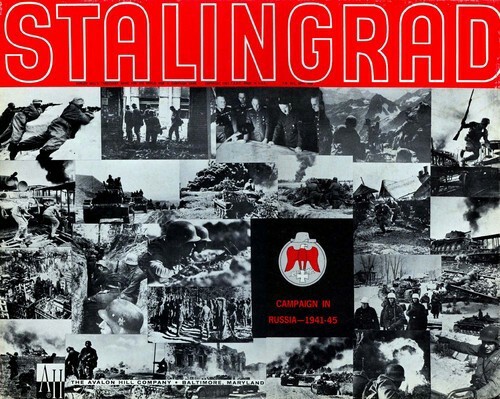
By 1963, iconic wargame publisher Avalon Hill had only published a few games, including Tactics, Gettysburg, Chancellorsville, and Waterloo. They all shared the same basic mechanics, which was that units had combat factors and movement factors, and you calculated odds and rolled dice. However, none of those games have anything to do with invading Russia. So when Stalingrad came out that year,* anyone who had a strong interest in rolling dice about the eastern front had exactly one choice in that regard. And it turns out they had a lot to say about it.
If you look at the list of articles from Avalon Hill’s The General magazine (its bimonthly lifetime), you’ll find a lot of articles about Stalingrad. At least one of them is penned by a Gary Gygax. After reading it, you can bet Mr. Gygax spent a lot of time arranging and re-arranging combat factors, surveying river lines, and studying combat tables. I’m not qualified to pass judgments on his “Southern Gambit” of Nov-Dec 1974, but I find it somehow comforting that the high priest of role-playing was clearly intimately familiar with the consequences of a “Defender Retreat” result.
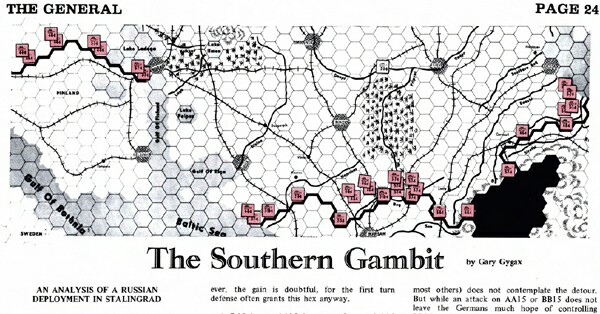
Stalingrad had all the hallmarks of an early board wargame. You had a hex grid, and some units.** You moved those units, and then attacked. Then it was your opponent’s turn. He or she did the same. Sort of like Monopoly, but with bombing instead of buying.
The problems with this are obvious. If you attack, you must have already moved. So even if you are successful, your opponent can form a line on his turn just behind his previous one. Then you move, attack again, and even if you succeed again, this cycle is repeated. That works ok for World War I, where units didn’t move all that far, or for Napoleonics, where there wasn’t necessarily another line of units. But what about a far-ranging panzer blitzkrieg?
That’s pretty much how Stalingrad played out as well. It was a slow grind from defense line to defense line. Not how the real campaign worked at all.
But many of those early articles about Stalingrad suggested things called “variants.” These were totally crazy ideas about how to make the game more exciting, or realistic, or balanced, or a combination of those things. Lou Coatney famously took his debate with George Phillies about revisions to the Stalingrad rules to the point of designing and publishing his own game (Sturm Nach Osten), which I bought sight unseen via magazine advert while in high school. It came in a ziploc bag with a nice rulebook, map, and counters.
One game which tried to model the peculiarities of the war in the east was The Russian Campaign designed by John Edwards and published by the Australian company Jedko Games (1975). It quickly proved popular was published in the US by Avalon Hill in 1976. The Russian Campaign used a combination of overrun mechanics and double-impulse movement to try and simulate the slashing panzer warfare of 1941. For a long time, it was the definitive way to invade Russia with cardboard, and thus developed quite a following. As with Stalingrad before it, much ink was spilled debating the merits of opening setups.
One such blueprint was published in The General magazine in the March-April 1977 issue. Authored by J. Richard Jarvinen, it was called “The Viipuri Defense,” for reasons which are even more esoteric than this post is about to get.
The rules were fairly simple. Each unit still had combat and movement factors. Combat was odds-based, just like in Stalingrad. There were still rivers, swamps, and Stalingrads. If you could get to odds of 10:1, then the defending unit essentially ceased to exist on that turn, and subsequent units could ignore it and its zone of control (the six hexes adjacent to it, which stopped all movement). It had been “overrun.” The Germans also had “Stuka” counters, which boosted the odds by three oddses. So if you had a Stuka, you could get an overrun at 7:1 odds. The limitation was that the cardboard Luftwaffe only consisted of three of those. So you had to pick your battles carefully.
The kicker was that after combat there was a second impulse, in which most units had some ability to move further. So an opening setup had to somehow arrange the little cardboard squares in a pattern that couldn’t be overwhelmed by other cardboard squares in a way that would set imaginary panzers free behind the line to run rampant in a second impulse. Lots of brainpower was expended picking up little chits, putting them down, doing arithmetic, and then trying it a different way. I know this from firsthand experience that happened thirty years ago, but somehow feels like it was just last week.
I remember the first game of The Russian Campaign I ever played by (postal) mail. I was the Russians, and spent a long time devising a setup without the benefit of any magazine articles and sent it off, pleased with myself. When got the mail two weeks later with the first turn, I found my opponent obliterated my southern defenses and was attacking Kiev, and it was clear there was no way I could regroup with half the German panzer army on the loose in the south. I didn’t understand how that could happen, so I assumed he had made a mistake, and reminded him that each Army Group was limited to attacking its designated opposing military district on the first turn. In response, I got an explanation that, no, there had been no error: if I just read the rulebook a little more carefully this time, I’d see that the limitation was not for the first turn, it was for the first impulse. I conceded that game and we started again.
Really, though, there was no way that Hitler was going to set up his whole army in Rumania just to take advantage of Stalin not putting enough combat factors in hex X20 to prevent an overrun. This just emphasized how these were math puzzles dressed up with tanks. If you like this kind of schwerpunkt sudoku, take a look at the picture below.
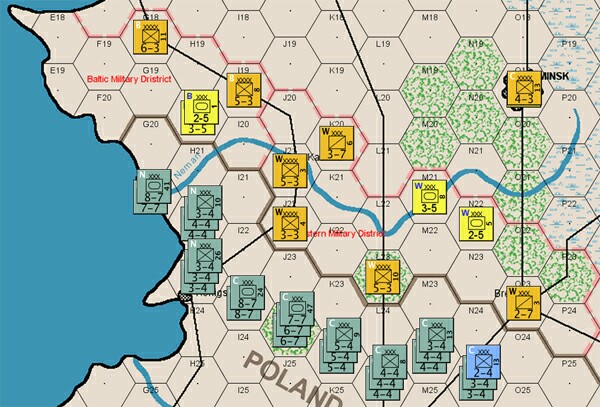
It’s the Baltic and Western Military Districts setup as described in The Viipuri Defense, consisting of eleven yellow and orange units. You have twenty five units to attack with. The first number is combat strength, the second is movement. Tanks (but not infantry) have to stop when entering woods (the green stuff). All units have to stop when moving next to an enemy, and any enemy with a unit adjacent to it has to be attacked by at least one unit. Units marked “N” (Army Group North) can only attack units marked “B” (Baltic Military District). Units marked “C” (Army Group Center) can only attack units marked “W” (Western Military District). The brown line is the border, and you can set up your units anywhere you want on your side of it, maximum three to a hex. You also get three Stukas. Can you figure out a way to blast through the defense in the first impulse and set your panzers free in the rear?
If you’re stumped, you can check out this reproduction of the follow-up article, “Back to the Viipuri,” published in The General dated March-April 1981.
Thanks for indulging me by sitting through all that. I love recounting stuff like this, because as far as I’m concerned, it perfectly captures the state of wargaming thirty years ago. Some guy would painstakingly devise a setup for one of the more popular games. He would then send it to The General, which would publish it like some sort of papal encyclical. Upon getting their copies in the mail, a bunch of other guys would then try to break it, and someone would point out the flaws and publish a new version. Then the cycle would repeat. It was like the peer review process of cardboard geekery. Note that the time between the original Viipuri article and the follow-up was four years. Now it would seem like forever if a follow-up article appeared in four days. The defense itself would probably have been broken in four hours.
Thirty years later, our games and game discussions look very different. Nobody publishes long, detailed strategy articles anymore, but you can find AARs for pretty much any wargame you like just by going to the right forum. Good ones by experienced players contain their own lessons. On the Matrix Games forums, a user named Tarhunnas posted an excellent AAR of the 1942-45 Campaign Game entitled Pride goes before a Fall Blau, which recounted his PBEM game playing as the Germans. Since the 1942 campaign and the Operation Blue scenario start at the same place, I thought I’d see how he tackled the first turn. His opening assault was extremely aggressive, essentially trying to pocket the entire Soviet army west of the Don on the first turn. Turns out it didn’t work, which posters immediately warned him when he posted his screenshots. I’m not that bold.
So I decided to try a single encirclement on the Voronezh front, and push east- and southeastward on the following turn. The picture below is what General Hoth would have seen if he knew how to use Photoshop.
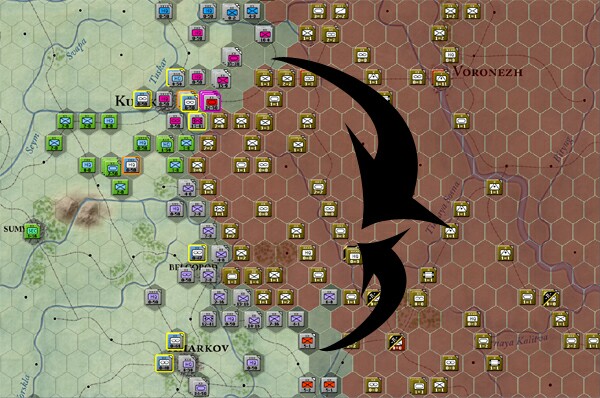
But reading history books and looking at AARs doesn’t give you much specific information about what moves to make. Games like War in the East don’t lend themselves too well to factor counting, anyway. There are just too many of them, and combat results can be quite variable. So you have to play the game by feel a lot of the time.
That doesn’t mean there aren’t numbers to think about. Take a look at the screenshot below, which shows the front line after I’ve attacked with a few infantry units. Because every unit gets to move no matter what other units do (in other words, time only passes for the unit that is moving), you can do a lot early in the turn to open things up later.
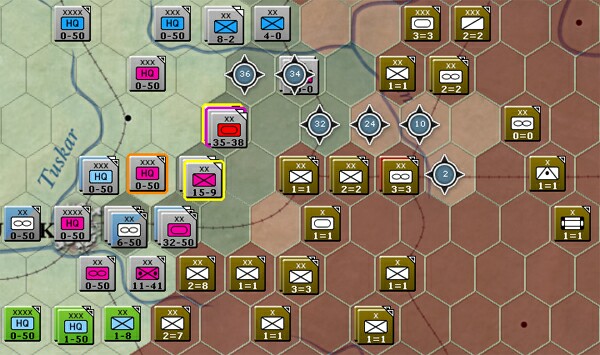
There is a small hole in the Soviet line, and the 9th Panzer Division (with 38 movement points!) is ready to exploit it. But it can’t go very far, because of the Soviet zones of control. Moving from one ZOC to another costs the 9th Panzer an extra six movement points. Crossing that minor river into an enemy ZOC is an extra six. You can see how fast 9th Panzer’s remaining movement drops off.
But we have a plan, and that’s to pocket all those Soviet units and then drive southeast. To complete the encirclement, we have to send 9th Panzer much further to link up with our southern pincer from XXXX Panzer Corps. To do that, we need to create a bigger hole.
Because combat in War in the East happens during movement, I’m free to take 11th Panzer Division and 3rd Motorized Division (both stacked with 9th Panzer) and move them individually, clearing out Soviet units as they go. Each attack costs them extra movement points, but they just need to get far enough to form the northern shoulder of the pocket while creating a hole for 9th Panzer to drive through. Fortunately, each unit is strong enough individually to just brush aside the Soviet rifle divisions that have a strength of 1. Once they do that, here’s the new movement situation:
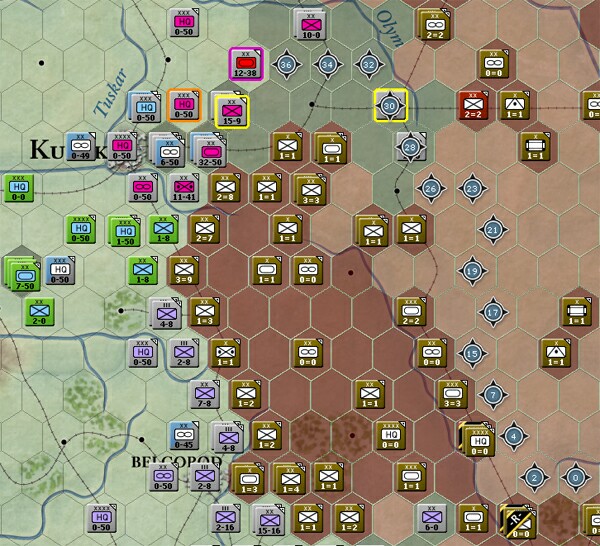
Those panzers can suddenly drive a lot farther!
This combination of movement and combat is a lot more time-consuming to describe than a single diagram showing the breakdown of the Viipuri defense. But even accounting for the fact that War in the East has a lot more units than The Russian Campaign, the variations that can happen during moves (such as unsuccessful combat that slows the attackers down and bleeds movement points) make it almost impossible to trade “perfect plan” ideas for a game like this. That’s a loss, in a way, because we don’t talk about games the same way now that we did. On the other hand, simple games like The Russian Campaign turn almost chess-like when you’ve studied them long enough. I wonder how long they would last if people posted exhaustive deconstructions at the pace of forum discussion. Maybe some secrets are best revealed over an actual game board.
To set the tone, I found the section in David Glantz’s book To the Gates of Stalingrad where describes the beginning of the 1942 offensive.
Hoth’s and Weichs’ artillery announced the beginning of Blau I with an intense 30-minute artillery preparation, while Luftwaffe supporting aircraft delivered concentrated air strikes against the Soviets’ forward defenses and lines of communications. Stung by the devastating strikes, only limited Soviet counterfire responded to this barrage. Then, as German guns shifted aim to deeper targets, Hoth’s armored spearheads rolled forward at 1000 hours [on 28 June 1942 -bg] meeting minimal resistance. Preoccupied with the threat to Moscow and the local German offensives to the south during the two weeks previous, the Soviet defenders had not expected the Germans to attack due east from the Kursk region. Almost half of Bock’s 68 German divisions, supported by a welter of satellite units, began the offensive with enormous success.
So did mine. Next week we’ll take a break for Christmas.
After that, on to Rostov!
__________________________
*For perspective, that was only twenty years after the end of the battle, whereas almost fifty years have now passed since the game’s publication. Just an example of how much more immediate the memories of those events were at that time, compared to now.
**I know, Tactics and Gettysburg had squares, not hexes, and the whole thing comes from German Kriegspiel, etc. Allow me my abbreviated highlight version.
***The Russian Campaign actually got a revision to a 4th edition by L2 Design Group, published in 2003.
Discussion
No comments yet.